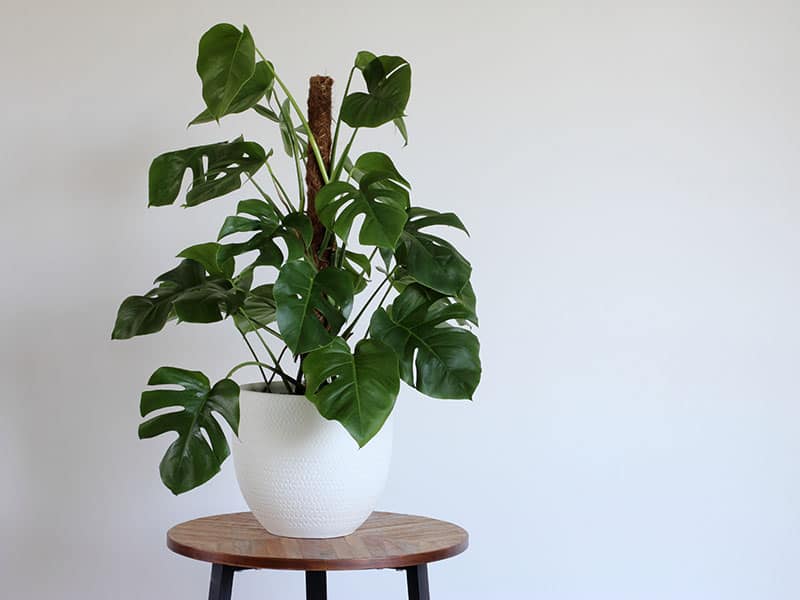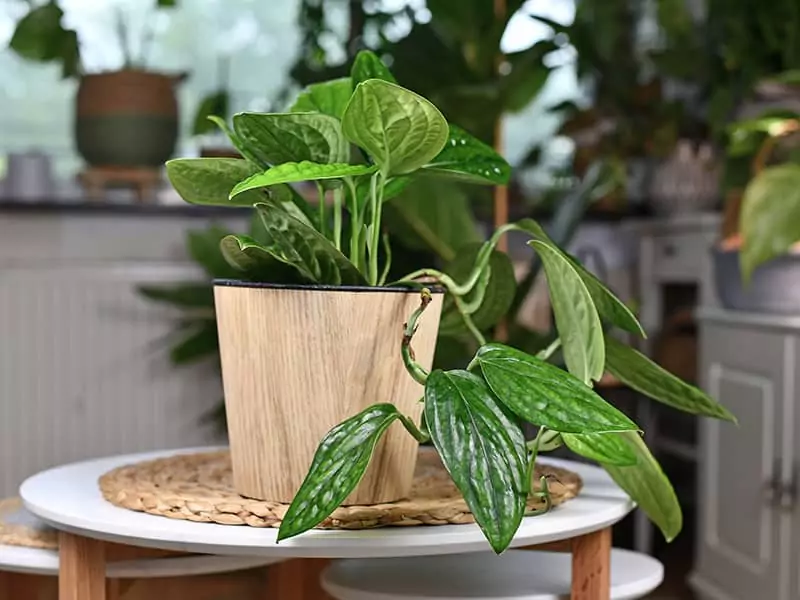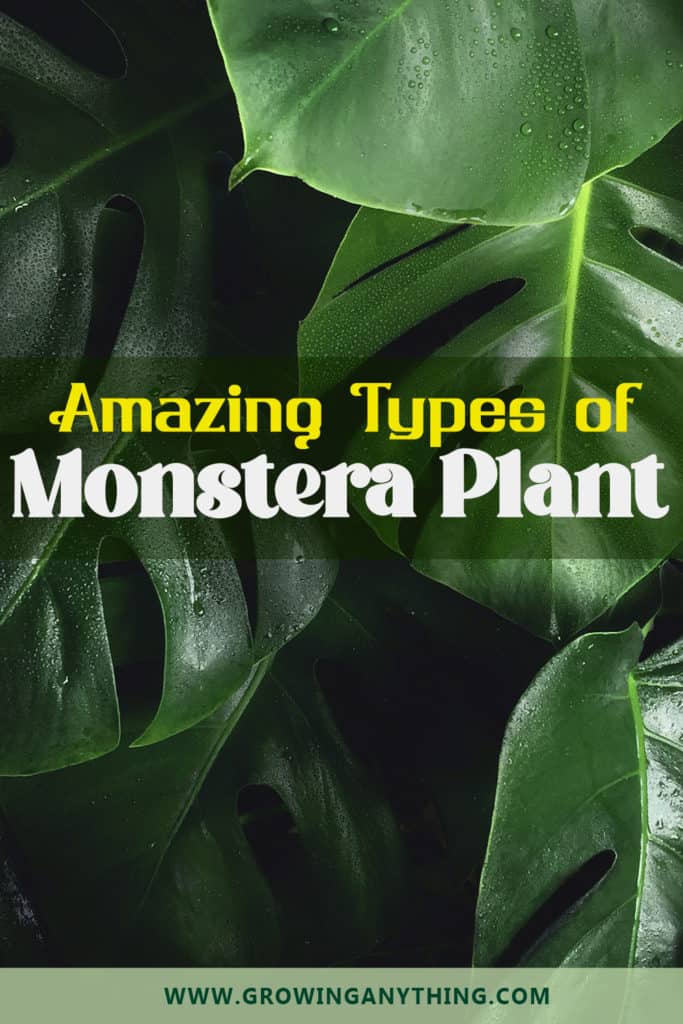17 Difference Types of Monstera Plants
There are several types of Monstera plants, including common and rare varieties. Monstera plant is a timeless and fashionable houseplant, with high visual interest. All Monsteras have ornamental leaves and often need only basic care. In fact, the plant got its name from the unique leaves with large holes.
My selection of best Monstera plants includes the variegated and non-variegated varieties!
Overall, Monstera is an easy plant to grow, as long as you keep the soil moist and ensure high humidity. But, each variety may be specific about the soil and watering requirements!
Here is what you need to know about various types of Monstera plants!

1 Variegated Monstera
Monstera borsigiana albo variegata has stunning leaves with creamy white variegations. The variegations in Albo Monstera are a result of chlorophyll mutation in the plant. It is a very expensive and rare plant. So, if you get your hands on it, do keep it!
Because the only propagation method possible is using cuttings from the mother plant, Albo variegata has a great resale value.
The best way to ensure the plant and foliage gets enough moisture is to shower the plant regularly when you feel the top inch layer of soil is dry. Showering the plant will also wash away the dust and leave the leaves looking glossy! Other than that, caring for Monstera Albo is simple.
2 Thai Constellation Monstera
Thai Constellation Monstera is another variegated type of Monstera plant. The variety looks similar to Albo when young. But as the plant matures, it becomes easier to distinguish the two types. Also, the leaves become glossier and prettier. Thai Constellation Monstera features much smaller variegation and small dots of white color of the plant foliage.
The plant is also low-maintenance but needs enough light and moisture to keep the variegations bright. Interestingly, the plant comes from the laboratory and not nature!
3 Swiss Cheese Plant
Monstera deliciosa or a common Swiss Cheese plant is the most common Monstera from the list. It features large leaves with charming holes in them. The plant has aerial roots and is one of the easiest indoor plants to grow. Therefore, it is a great plant for beginners.
It needs medium light, medium warmth, medium watering, but may adapt to different conditions. You can also prune the plant to keep it in the desired shape and size. The ideal time for pruning the plant is spring. That way, the plant can heal in the growing season.
4 Matuda
Monstera acacoyaguensis or shortly Matuda is a lovely tropical plant that brings the jungle vibe into every space. Matuda is a rare Monstera variety, so only a few nurseries are lucky enough to offer the plant.
Due to its tropical origin, Matuda enjoys warm temperatures and high humidity. But, keep the soil loose and well-drained to keep the roots healthy.
You can propagate Matuda by stem and leaf cutting.
Also, the plant Matuda is cold-sensitive and toxic to humans and pets.
5 Monstera Subpinnata
Monstera Subpinnata comes from Ecuador and has an elegant appearance. The leaves are glossy and have almost perfectly symmetrical holes. Moreover, Subpinnata is a vine that keeps a thin appearance and fern-like leaves as it matures. Unlike other plants, Subpinnata leaves aren’t huge.
The plant needs a medium warm temperature and moderate light. It makes it perfect for semi-lighted corners in your home!
Subpinnata is one of the Monstera plants that can be grown as a patio plant in zones 4-11. But, if the temperatures drop significantly, bring the plant inside! You can also rotate the plant to ensure consistent growth and dust the leaves to keep them glossy!
6 Monstera Adansonii
Monstera Adansonii deserves the nickname Swiss Cheese because it has more cheese-like holes than any other Monstera type. Because the leaves are fully perforated, the plant looks compact and not bulky at all. It fits great into all indoor spaces and you can display it with other plants.
When potting the Monstera Adansonii, pick potting mix with peat. It will prevent waterlogging, the most common plant killer! Place the plant so it can enjoy bright, indirect light and water when the topsoil gets dry. You can trim new vines to encourage new growth and keep it good-looking.
7 Shingle plant
Monstera acuminata or Shingle plant comes from Guatemala and is known for its beautiful leaves and air-purifying properties. Overall, the plant isn’t huge like other Monstera varieties. The stalks on which leaves appear are usually six inches tall, and average leaf blades are between six and ten inches.
Surprisingly, the Shingle plant is one of the tallest trees in its native habitat! As a household plant, the Shingle plant is a low-maintenance plant with high visual interest.
Keep in mind that the Shingle plant needs time to establish, so don’t worry that you’re doing something wrong! After some time, the plant will develop faster.
8 Monstera Obliqua
All Monstera plants have unusual leaves, and Monstera Obliqua is probably the easiest one to identify. The leaves feature large holes, and generally, there are more holes than leaf material.
The plant is expensive, and not beginner-friendly. Of all Monstera plants, the Obliqua variety is the trickiest to keep alive. Direct sunlight may kill the plant, as well as overwatering.
Obliqua has a slow growth rate, and as the plant matures, the holes develop and become larger, and the stems remain upright. Overall, it is a true gem for every experienced plant collector!
You should see the video below:
9 Monstera Pinnatipartita
Unlike Monstera, the Pinnatipartita is an easy-going plant with a moderate growth rate. It grows very tall in tropical rainforests of Ecuador and Peru. The plant thrives in the soil mixed with plenty of organic matter, so add mulch and compost in the pot.
Interestingly, Pinnatipartita climbs to get more light, so pick a semi-shaded location, but leave room for the plant to grow. Also, keep your plant away from direct light as the leaves are prone to burning. Just like with other Monstera plants, the soil needs to remain moist, but not soggy.
10 Monstera Dubia
Dubia Monstera is a small and not very popular type of Monstera species. But, if you are a true Monstera lover, Dubia will become a great addition to your collection.
The plant features small leaves in the shape of a heart. When the plant is young, you won’t notice the perforation on the leaves. But, the stripes of light and dark green make the plant beautiful.
Because Monstera Dubia is a climber, you’ll have to provide a trellis or similar structure. Monstera Dubia is low-maintenance, and it needs watering once a week during summer and growing season. During winter, water the plant once in two weeks.
11 Silver Monstera
Monstera Siltepecana or Silver Monstera comes from South America. It is a large vine with highly ornamental foliage. To keep the plant healthy, pick a spot that receives a lot of bright but indirect light.
When it comes to temperatures, Silver Monstera is very adaptable. It can survive hot temperatures around 90 degrees Fahrenheit, but temperatures lower than 55 may damage the plant.
Ideally, keep the humidity over 60 percent or spritz the foliage regularly.
Check out what will happen to Silver Monstera if you keep it in a shady spot.
You should see the video below:
12 Monstera Karstenianum

Monstera Karstenianum is sometimes called Monstera Peru because of its origin. It is the easiest Monstera to identify because the plant doesn’t have fenestrated foliage, like all other Monsteras.
Peru Monstera is compact and has textured leaves that look almost like Peperomia.
If you take good care of it, small and round leaves will develop in a dense pattern, and add a tropical vibe to every space.
The plant only gets a few inches tall and makes an excellent place for small apartments
Foolproof tips for taking care of Monstera Peru.
13 Monstera Esqueleto
Esqueleto Monstera features heavily fenestrated foliage, a signature characteristic of most Monstera plants. Each leaf has multiple holes, smaller and bigger, narrow and round. It is one of the ways to distinguish the Esqueleto plant from Adansonii Monstera.
The plant doesn’t need any specialized care, different from other Monstera types. Choose a well-draining soil, pick a location with bright, filtered light, use water and fertilizer moderately. Use fertilizer in spring and summer, and your Monstera Esqueleto will thrive. The IDeal humidity for the plant is above 70 percent, so you can even keep the plant in the bathroom.
Read the comprehensive care guide for the Monstera Esqueleto.
14 Monstera Standleyana
Monstera Standleyana is one of the most beautiful Monstera plants out there. The thick and fleshy leaves are speckled with cream and white!
As a houseplant, Monstera Standleyana usually grows up to five feet in height and spreads about three feet. In nature in Costa Rica, you can find these plants 20 feet tall!
The plant needs a lot of moisture but will survive only if the soil is well-draining. If the plant stops growing or starts to lose foliage, it is a safe sign that your Monstera Standleyana is thirsty.
15 Monstera Epipremnoides
Monstera Epipremnoides is an eye-catching plant, a favorite in many households lucky enough to have it. In addition to its beautiful look, Epipremnoides Monstera isn’t too difficult to keep alive.
Even though the plant comes from tropical areas of Costa Rica and Honduras, it has been adapted to indoor settings.
The leaves of Epipremnoides are a lighter and brighter green than most other varieties. They are also thicker and have a barely visible fuzzy texture. On top of everything, the leaves aren’t delicate and they can survive even low light conditions or too much light exposure.
The plant loves humidity. You can use a humidifier around it, or make a humidity tray with pebbles covered with water. Water the plant frequently, but never let it sit in the water, as it may cause roots to rot.
16 Monstera Punctulata
Monstera Punctulata is a hybrid variety of Monstera plants. It features large, ovate and elongated leaves, with very distinct fenestration on the sides of the leaves.
The foliage is brilliant green and features a soft texture. Puncultulata is a vigorous climber. In native Mexico, the plant climbs up on the nearby trees. Therefore, you can put the supporting structure in the pot to encourage climbing.
Monstera Punctulata is a rare and beautiful variety, but it may experience a few problems. Learn how to identify and fix the most common problems with all Monstera varieties.
17 Monstera Adansonii Variegata
Monstera Adansonii Variegata is a unique Monstera type. The foliage has fenestration and needs a lot of light to stay variegated with yellow and creamy white. If you ensure the plant gets enough sunlight, other care steps are simple. Water frequently and use fertilizer during the growing season.
Because of fenestrated and variegated leaves, the Monstera Adansonii Variegata is a true drama queen which quickly becomes a focal point in every plant setting.
Monstera Varieties are Low-Maintenance and Highly Rewarding Plants
If you are to have one plant to start your collection with, any easy-going Monstera variety will be perfect. These plants have beautiful foliage, unlike any other houseplant.
The best thing – they can adapt to almost all indoor conditions. So, the chances are that your Monstera plant will decorate your space for years, despite your actions.
However, don’t overwater it, as it can really mess up with the roots.
My favorite Monstera is the unique Monstera Obliqua. Which one is your top pick?
If you enjoyed the article, please share it with other plant-lovers so you can inspire them to get their own Monstera plants!
Come back for more plant lists and gardening tips!

